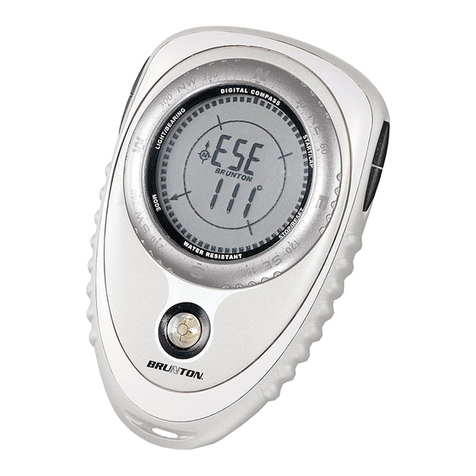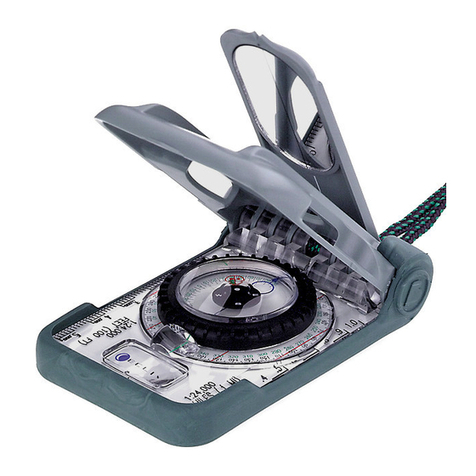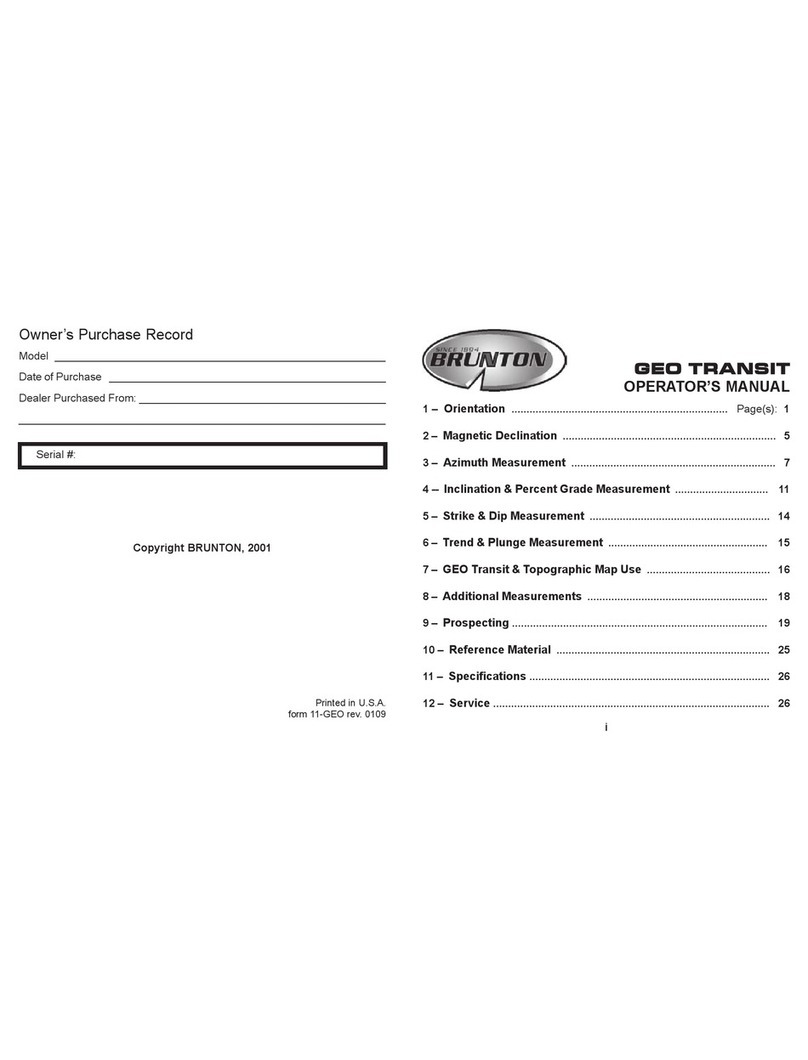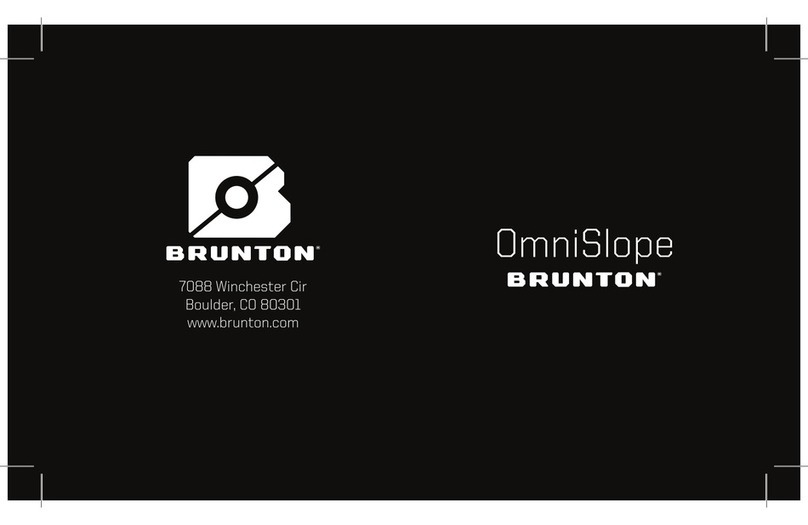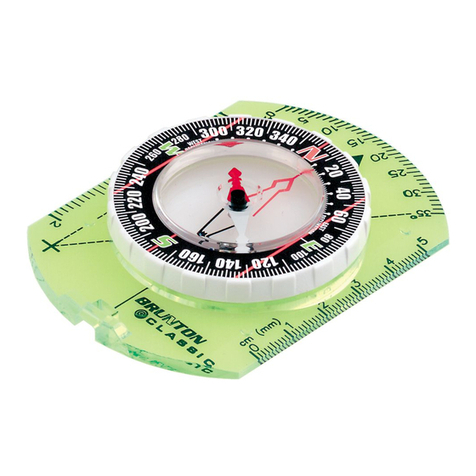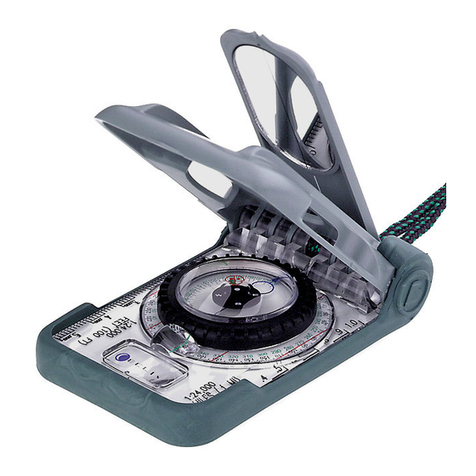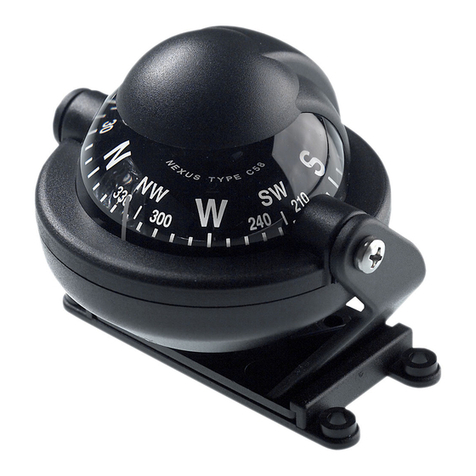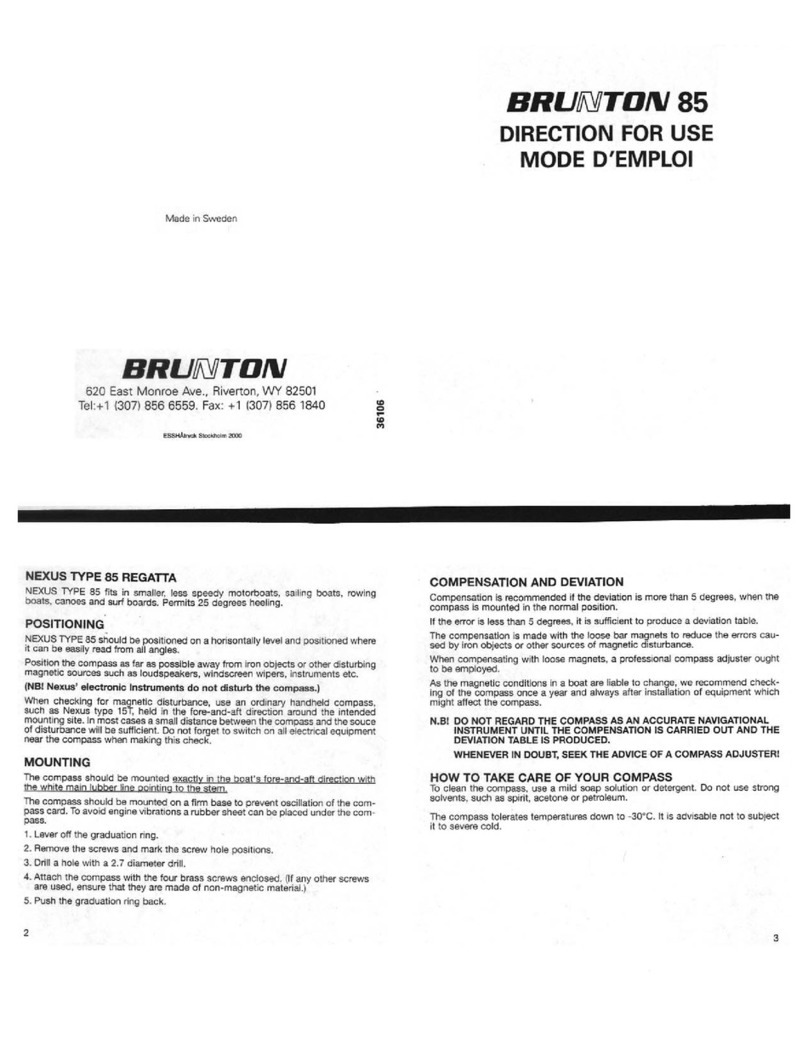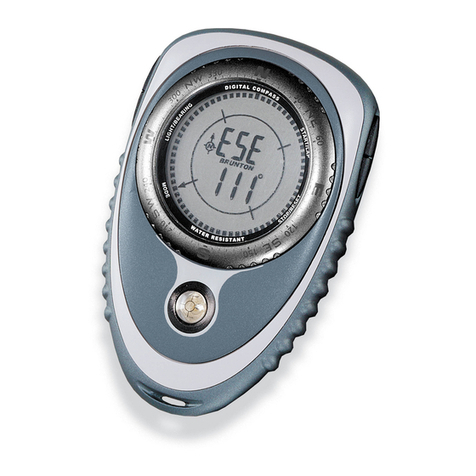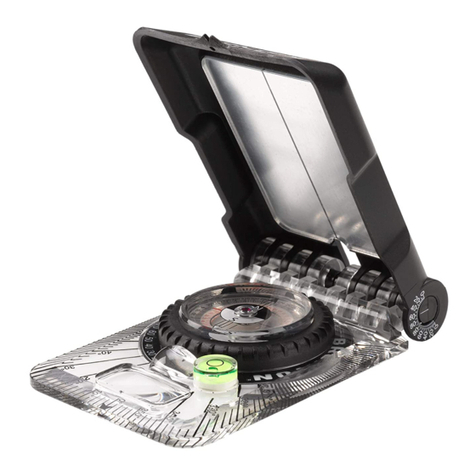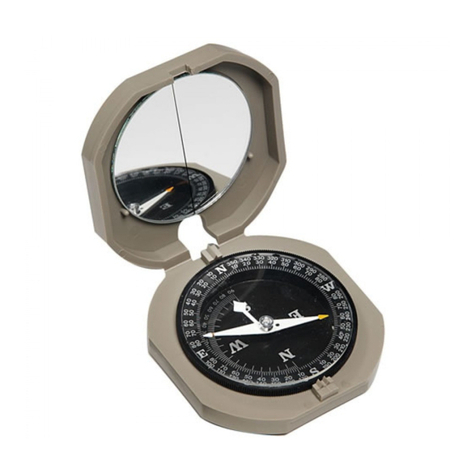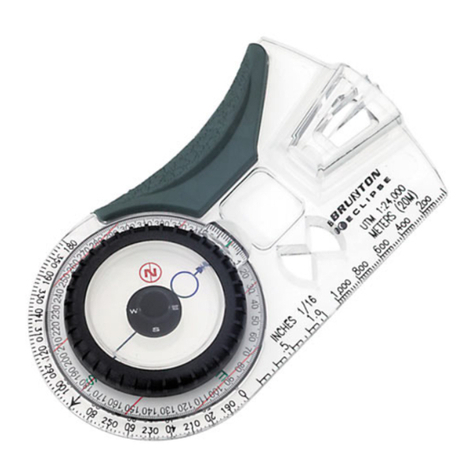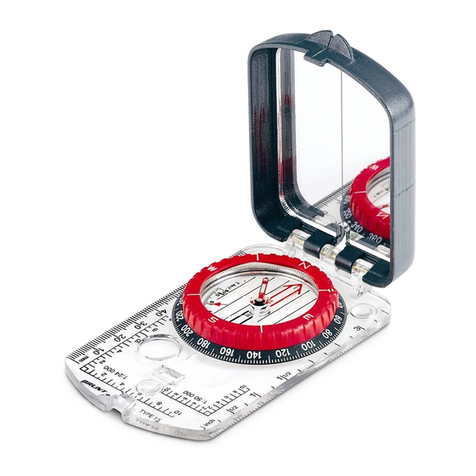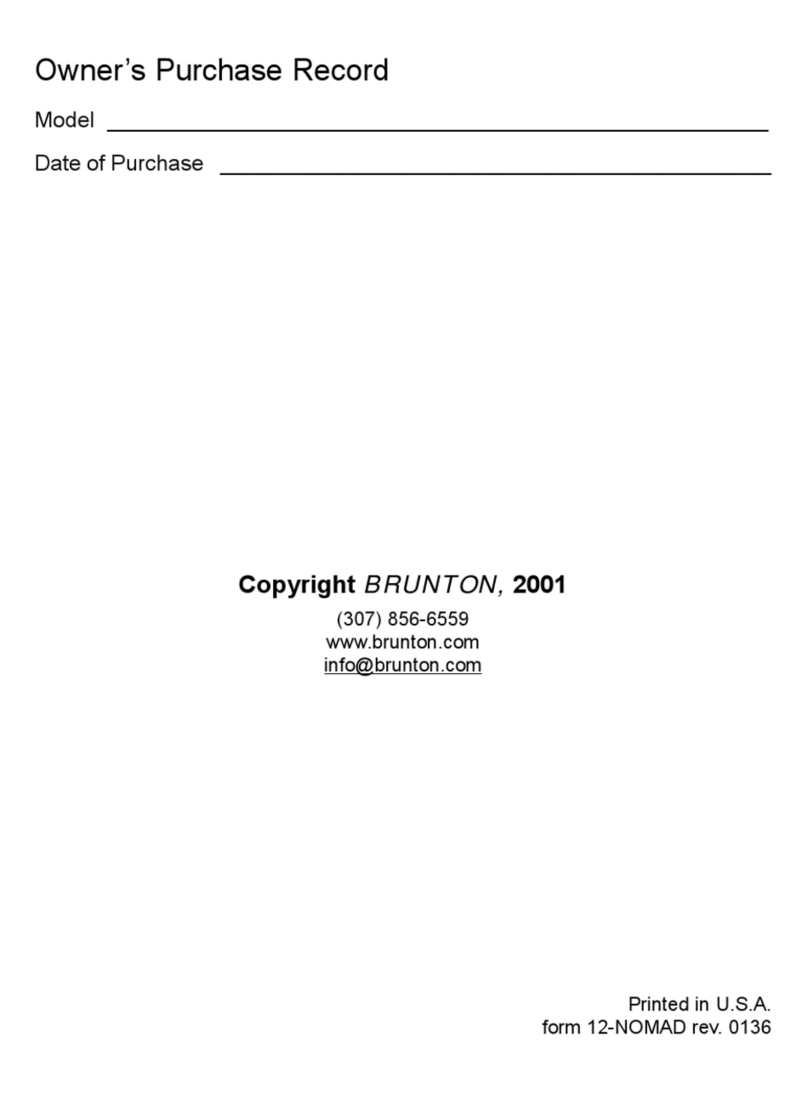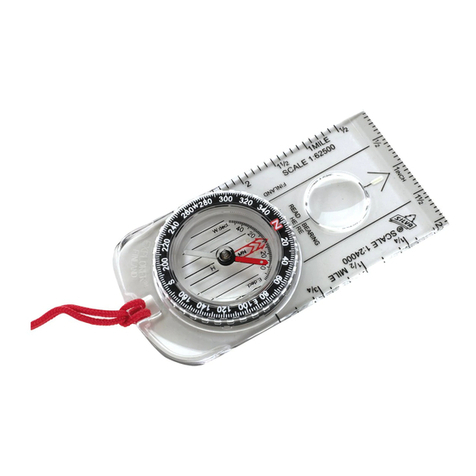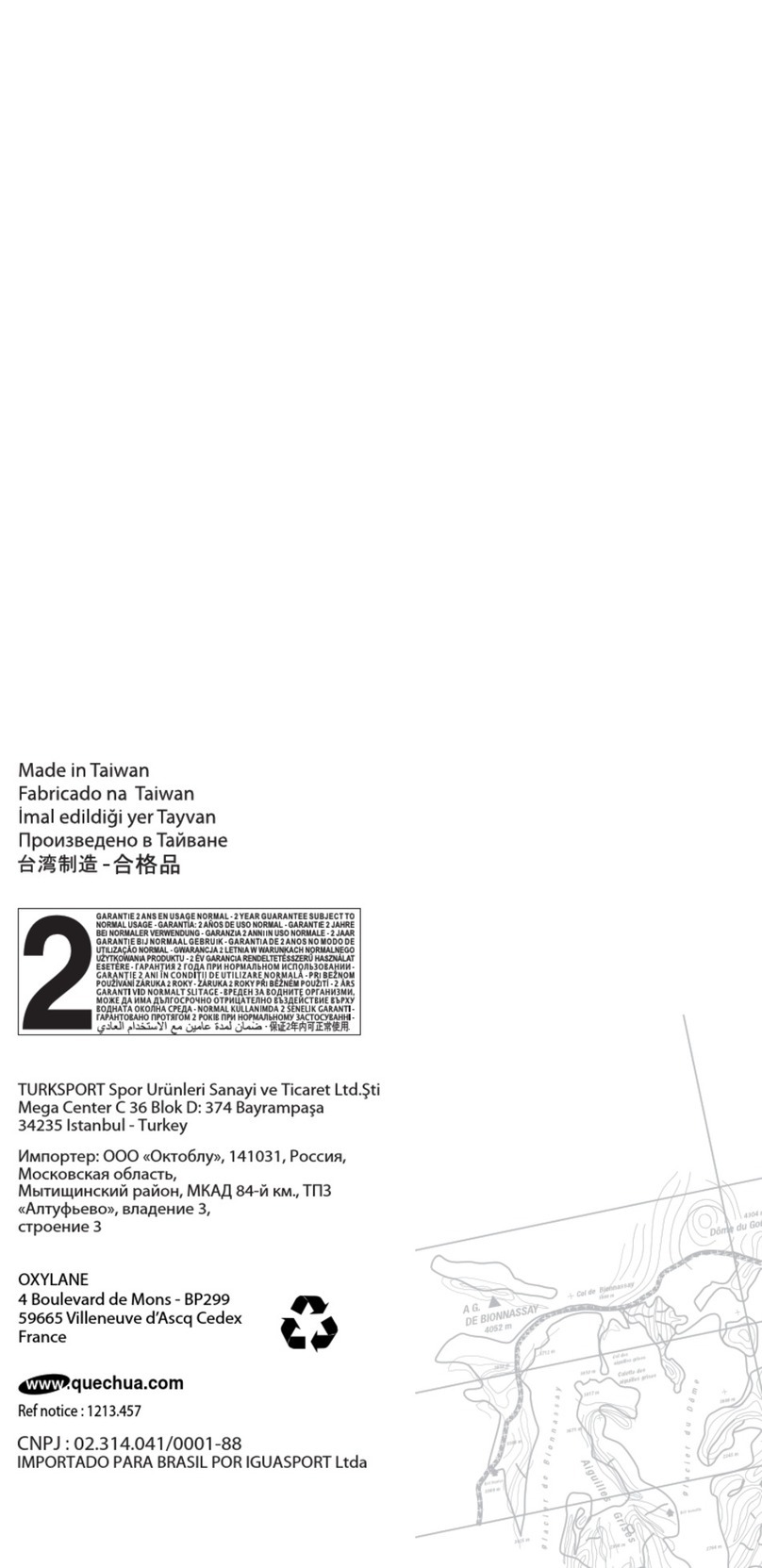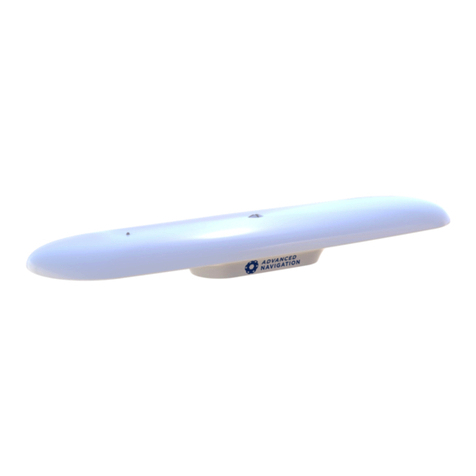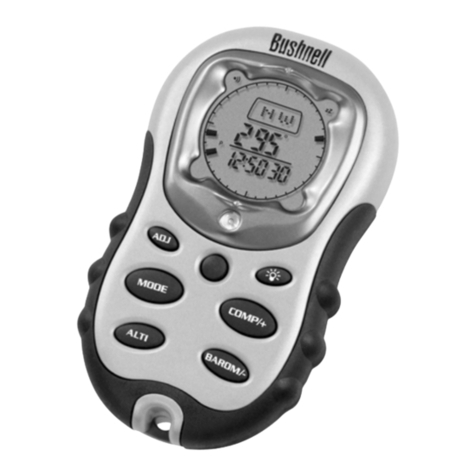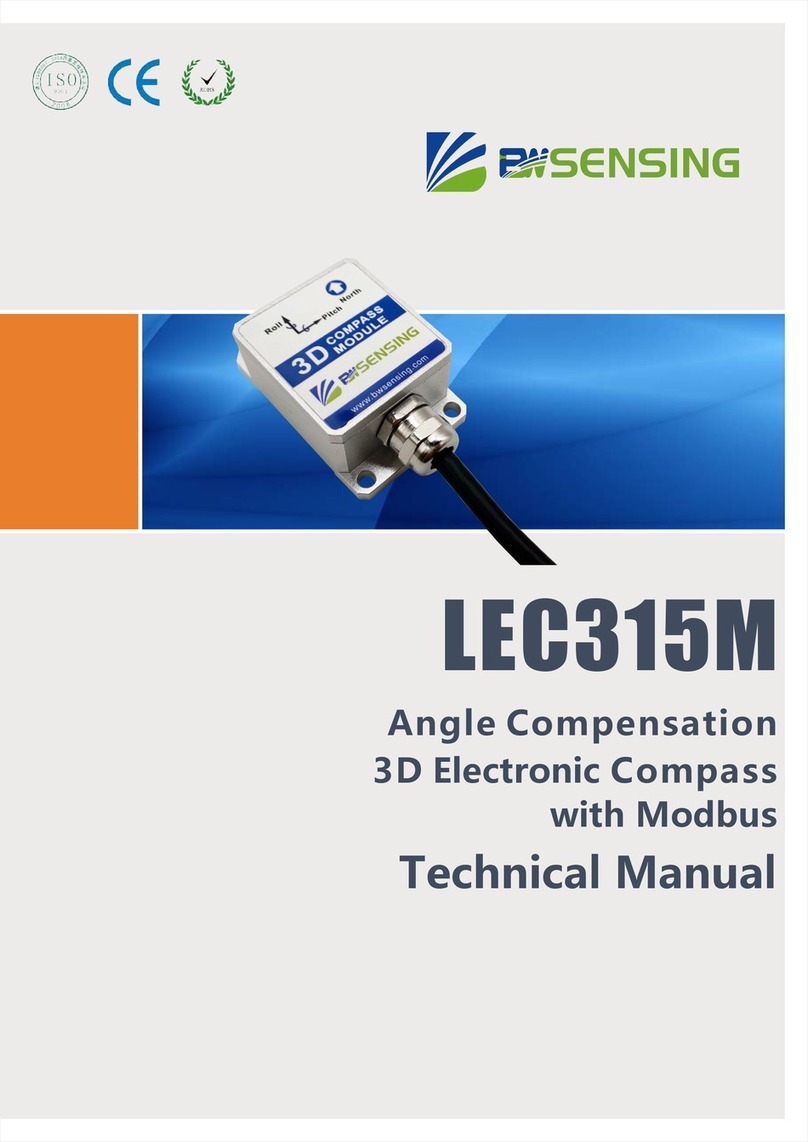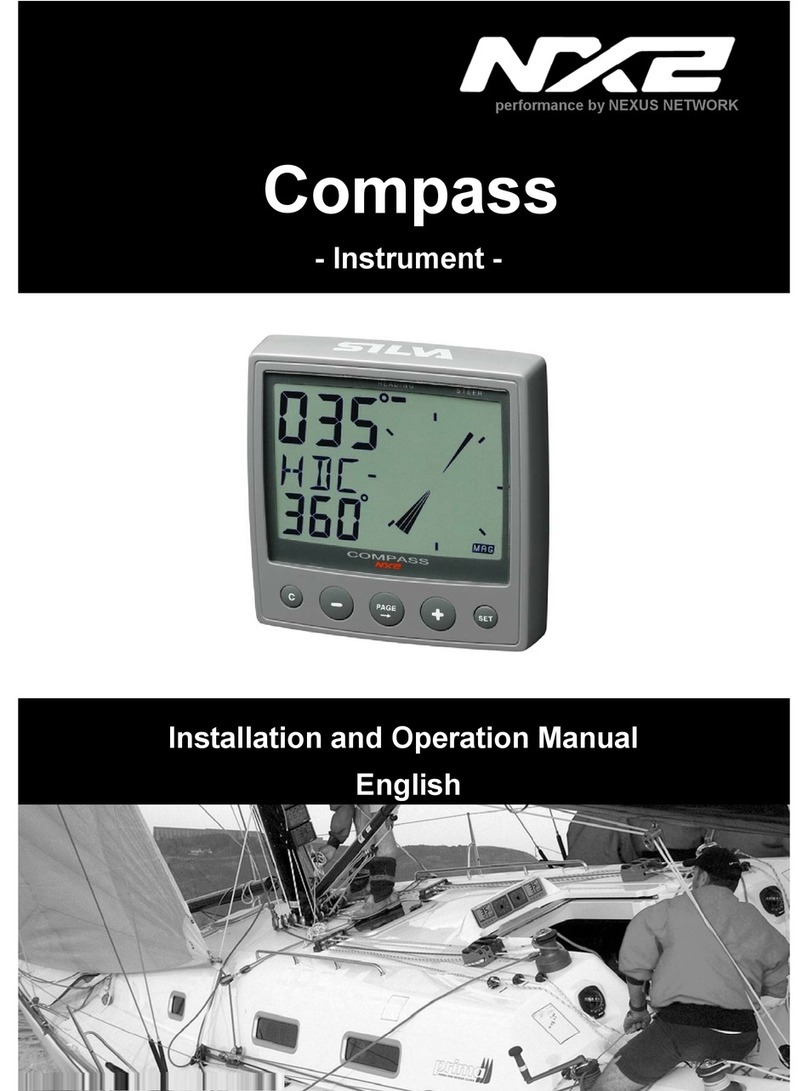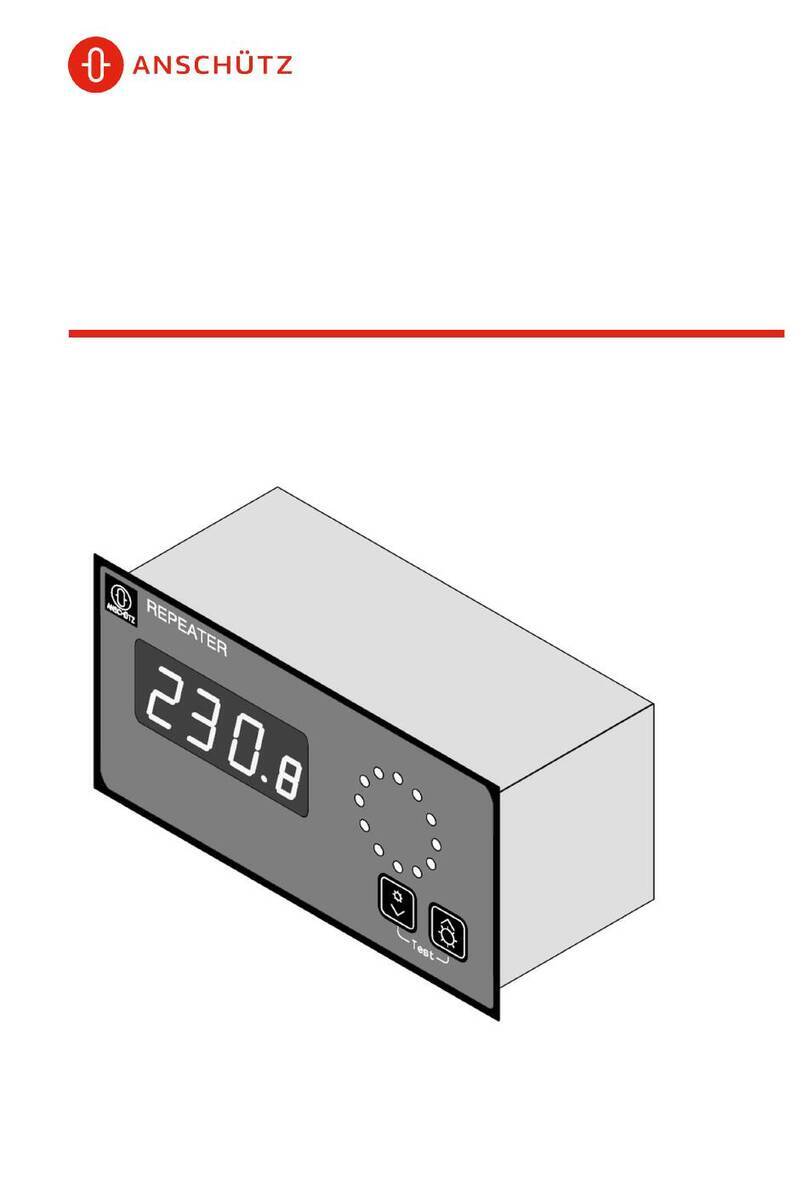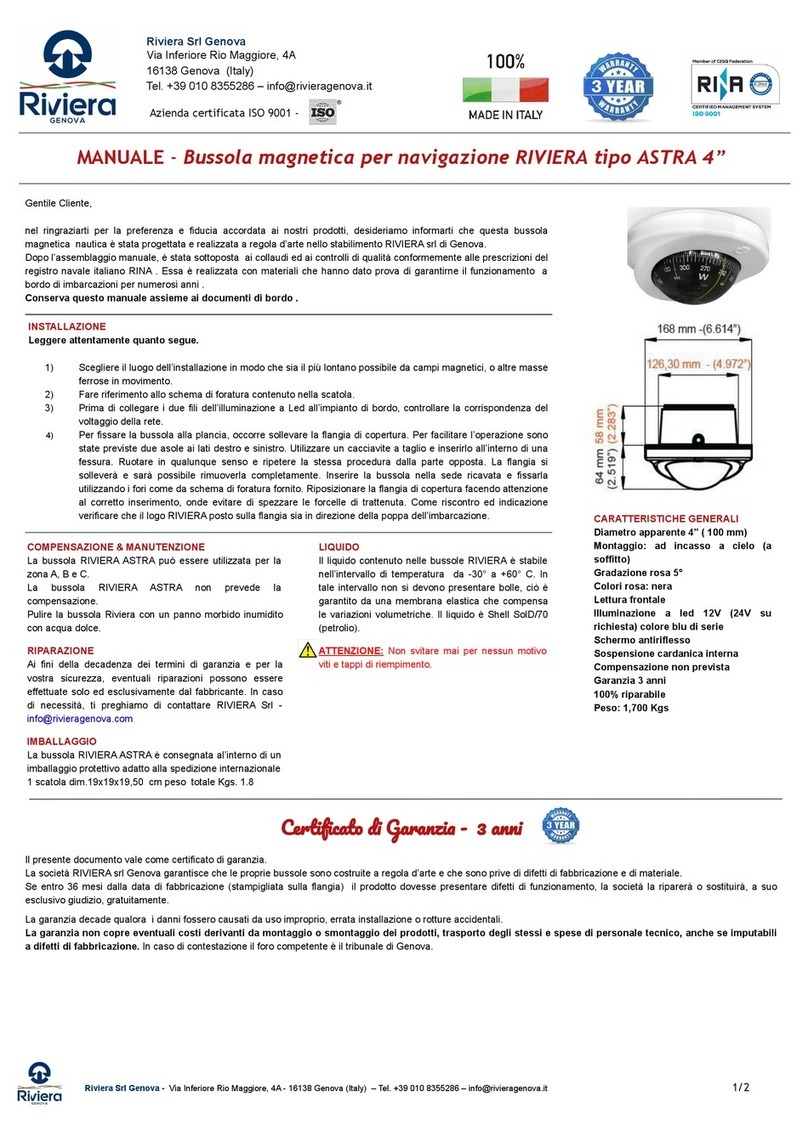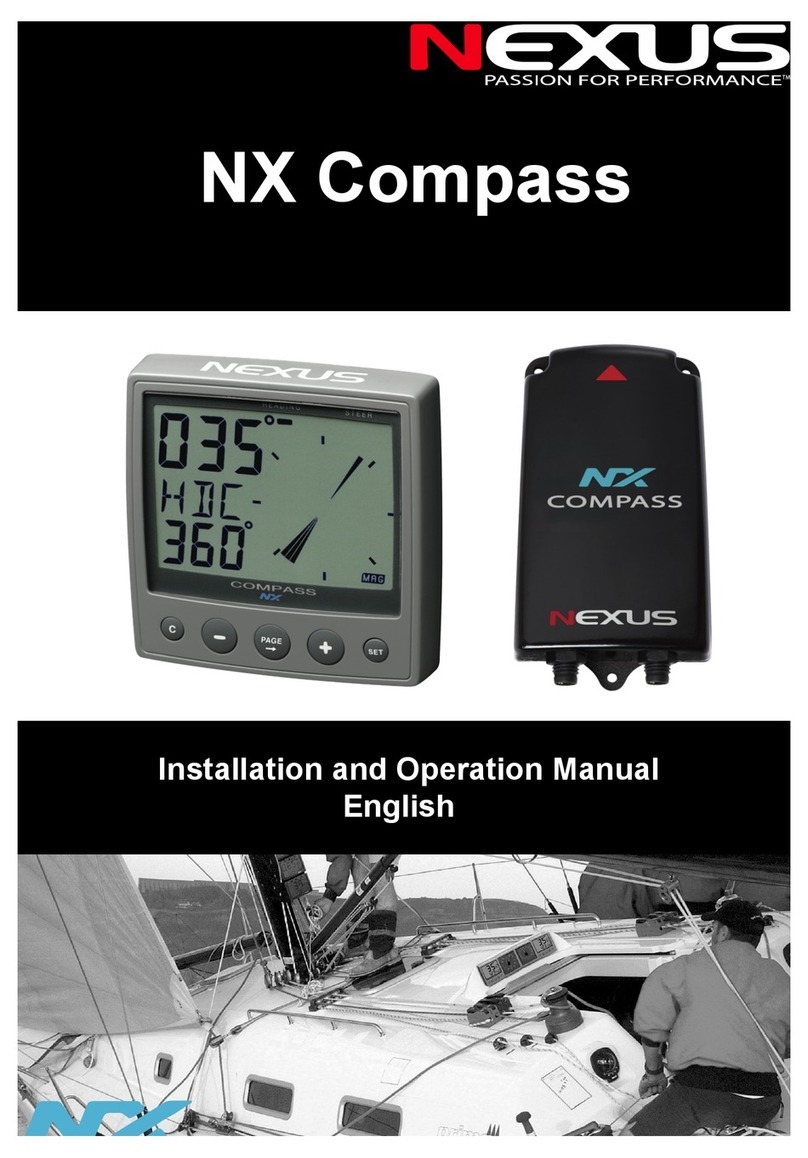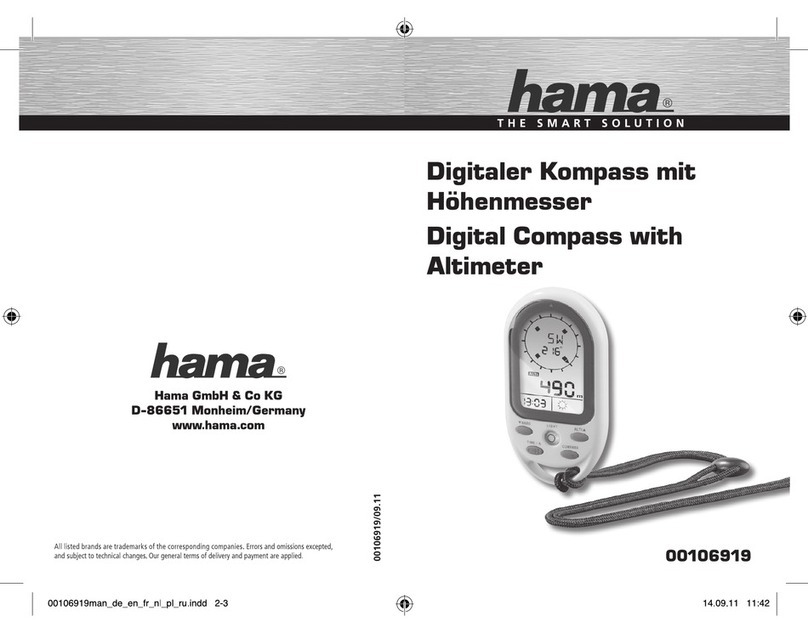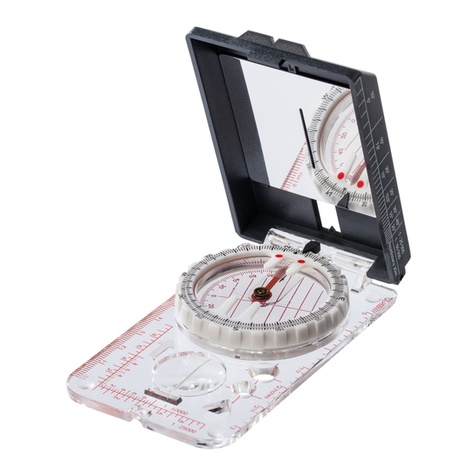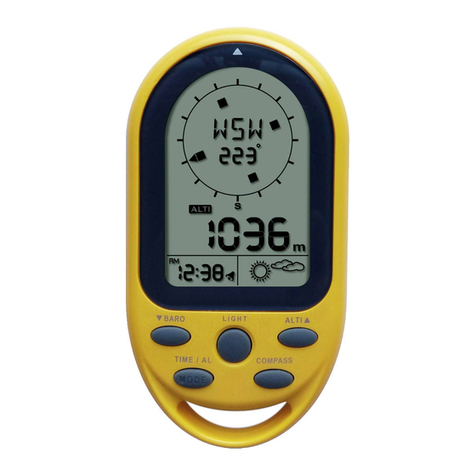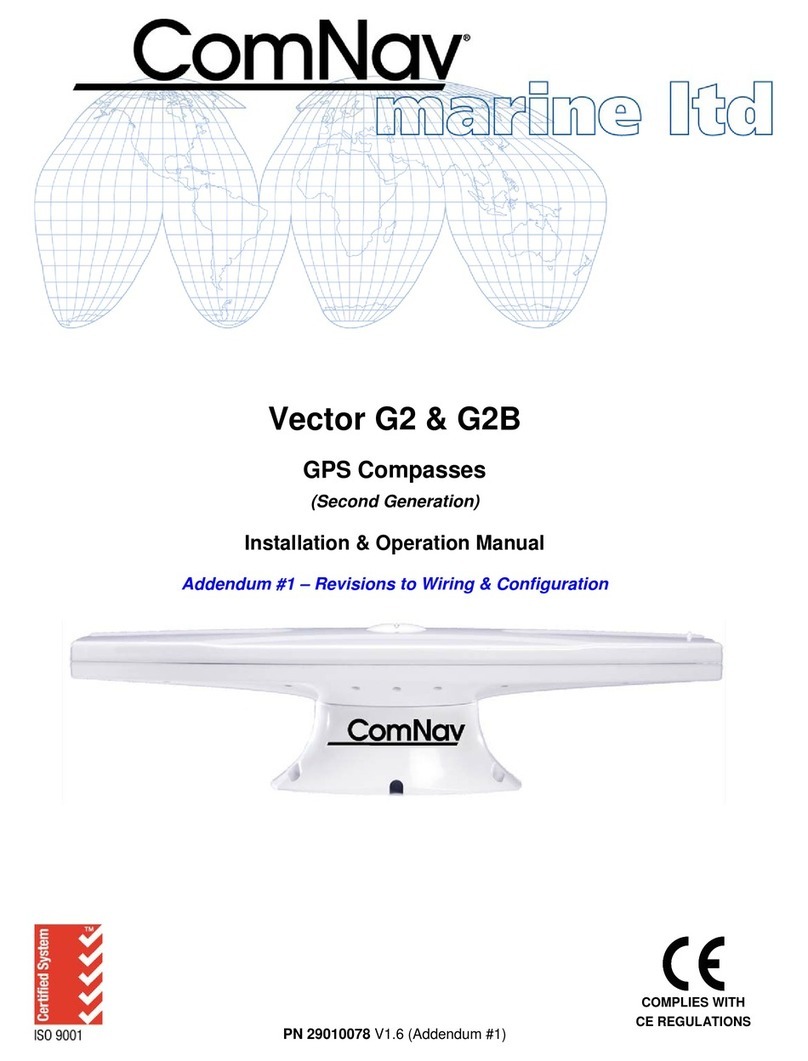Fig. 1
Brunton TruArc Compass—
Align the Circles and Find Your Way
Parts of the Compass:
1. Azimuth ring w/ 2° graduations (TruArc 10, 15, 20 - 1° graduations)
2. Orienting Needle Outline
3. Global Needle
4. Rotating Dial
5. Bearing Index line
6. Direction of Travel Arrow
7. Map Magnier
8. Inch/mm Scale
9. Liquid Filled Vial for Smoother Needle Movement
10. Ergonomic Base Plate
11. Declination Adjustment Scale
12. Declination Adjustment Index Line
13. On the Map Meridian Lines
(models 5, 7, 10, 15, and 20 only)
14. Lanyard lash point
15. Protective Mirror Cover
(models 7, 15, and 20 only)
Magnetic Declination
The difference between True North and Magnetic
North (which attracts your compass needle) varies
depending on your location on the globe. To nd your
current declination visit NOAA’s online declination
calculator here: www.ngdc.noaa.gov/geomagmodels/
Declination.jsp
Your Brunton TruArc Compass
features tool-free
declination adjustment. To
adjust, place your thumb
in the center of the liquid
lled vial, then pinch
the vial with your
fore-nger on the
bottom through
opening in the center of
the vial base. Hold the
rotating dial (part no 4
above) still with you other hand, and then twist the
liquid lled vial within the outer dial (g 1). Adjust to
the appropriate declination setting according to your
location using the red hash mark at the tail of your
magnetized needle. When complete, the compass will
automatically compensate for declination.
For example, if your current declination is 20 degrees
West (or 20°W) the compass should adjust 20 degrees
toward the West to compensate. The gure here shows
the factory setting at zero declination, and then com-
pensated according the declination scale (Fig 2a & 2b)
Finding your heading/bearing without a map
1. Select a visible landmark along the route you wish to
travel such as a rock formation or mountain top.
With the compass held level, point the direction of
travel arrow on the compass base plate at the
landmark. (Fig 3a) If you’re
using a mirrored compass,
center the landmark in the
sighting window, and position
the mirror so that a top view
of the compass dial is visible
in the reection.
2. Rotate the dial until the red outline aligns
with the north-seeking needle. Read your heading/
bearing at the index
line. (Fig 3b) When using a
mirrored compass, keep
your landmark centered in
the sighting window, and
align the needle with the
orienting arrow using the
reection shown in the
mirror.
3. Keep the needle aligned with the red orienteering
outline as you travel to your landmark. Repeat
procedure until your destination is reached.
If you know your bearing
1. If you have been given a bearing in degrees to
follow, turn the dial so that the index line aligns with
the correct bearing degree number. Hold the
compass level with the direction of travel arrow
pointed straight ahead.
2. Turn your body until
the needle is aligned with
the red needle outline. You
now face your correct
direction of travel (g 4)
3. Pick out a landmark along
your direction of travel and move towards it,
checking periodically that your needle
and red needle outline are aligned. Repeat this
procedure until your destination is reached.
Finding your way using a map
1. Place compass on map
with the straight
edge along your
desired direction
of travel. Make
sure that the
direction of travel
arrow points
toward your
destination.
2. Keeping the
compass in
place along
your desired
direction of travel, reposition
the map until red needle
outline and the needle
are aligned (g 5a & 5b).
3. In the landscape,
pick out a landmark
along your direction of
travel and move towards it,
checking periodically that
your needle and red needle
outline are aligned. Repeat
this procedure until your
destination is reached.
Finding your position on a map (triangulation)
1. If your location is unknown, identify (3) three
landmarks that can be seen in the landscape as well
as on the map. These would generally be obvious
rock formations, river bends or mountain tops.
2. Point the direction of travel at landmark #1 and nd
the bearing per instructions above.
3. Place your compass on the map, with one corner
of the straight edge on Landmark #1. Rotate the
base plate of the compass so that the needle
and the red needle outline align.
4. Draw a line along
the straight edge
of the compass
base plate,
extending it as
needed (g 6).
5. Repeat this
process for
landmark #2
and again for #3.
6. The triangle
formed by the
three lines
crossing will
approximate your position on the map.
Use of inclinometer to measure vertical height
(models 7, 15, and 20 only)
1. Rotate dial until West (270°) is at the index line.
2. Turn the compass on its side with mirror open out to
the left. Position the mirror until you can see the
reection of the graduated dial.
3. Sight to the top of the tree or rock formation you
are measuring through the mirror’s sighting window.
4. In the reection, read the incline where the red
clinometer arrow points at declination scale.
5. Use the sloping ground illustration and tangent table
to calculate vertical height (g 7)
NOTE: Never expose your compass to extreme tem-
peratures exceeding 140°F or below -30°F. Remember
that your compass functions using a magnetic eld.
Prolonged exposure to electronics, stereo speakers,
knives, metals or other magnets (anything with a
magnetic eld) can cause your compass to lose or
reverse polarity. Always check the functionality of
the compass before relying on it in the eld. Brunton
recommends avoiding contact with insect repellents or
sunscreens containing DEET. These can damage clarity
of the compass and wear off necessary scales and
markings.
Warranty
Please register your TruArc Compass by visiting www.brunton.com/reg-
ister. Brunton has taken every effort to ensure years of trouble-free use
from your new product. This product is guaranteed to be free of defect
in material and workmanship according to local regulatory requirements.
This product is not subject to guarantee from third-parties and is subject
to change. Brunton will repair or replace with a new equivalent, without
charge for parts or labor, per Brunton’s discretion. Brunton cannot be held
responsible for accidents, damages or injury occasioned by the use of
this product. Warranty will be rendered invalid if product is damaged by
tampering, negligence, or misuse.
BRUNTON
7088 Winchester Circle
Boulder, CO 80301
www.brunton.com
Fig. 5a
Fig. 2a
Fig. 6
Fig. 3a
Fig. 5b
Fig. 3b
Fig. 4
Fig. 2b
7
1
13
10
11 12 14
9
4
8
2
Model TruArc 5 Pictured
3
5
6
Height On Level Ground - (g 7) left
Height = (tanA + tanB) x distance
= (tan30˚ + tan14˚ ) x 66’
= (.577 + .249) x 66’
Height = (.826) x 66’ = 54.516 = 54.5’
Hauteur au niveau de sol - Figure 7 à gauche
Hauteur = (tangente A + tangente x distance
= (tangente 30˚ + tangente 14˚)
x 66 pi
= (.577 + .249) x 66 pi
Hauteur = (.826) x 66 pi = 54,516
= 54,5 pi
Height On Sloping Ground -
(g 7) right
Height = (tanA + tanB) x distance
= (tan42˚ + tan4˚ ) x 66’
= (.900 + .070) x 66’
Height = (.830) x 66’ = 54.780 = 54.8’
Hauteur au niveau de sol - Figure 7 à gauche
Hauteur = (tangente A + tangente B) x distance
= (tangente 42˚ + tangente 4˚) x 66 pi
= (.900 + .070) x 66 pi
Hauteur = (.830) x 66 pi = 54,780 = 54,8 pi
TruArcTM

